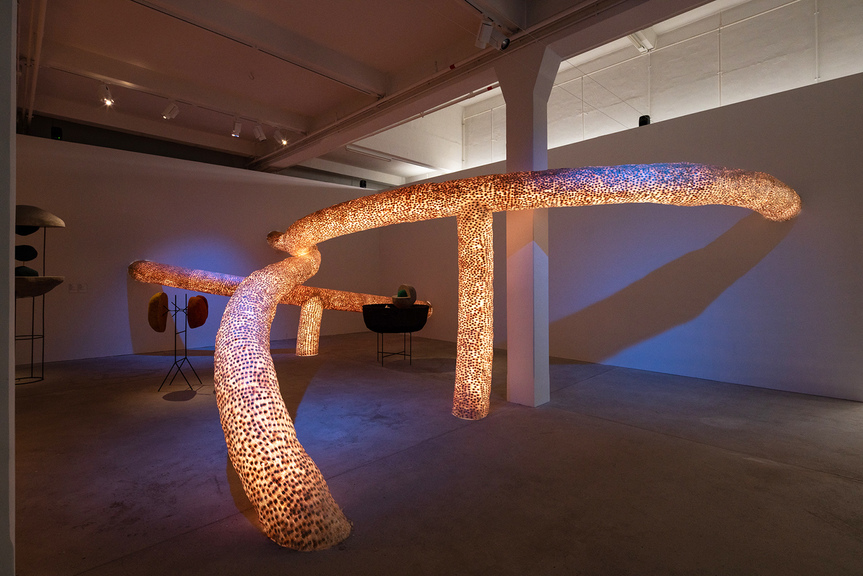
R
E
V N
E
X
T
Art After Hours: Mood Indigo Screening at Tai Kwun Contemporary, Hong Kong, 2018. Courtesy Eunice Tsang and Tai Kwun Contemporary, Hong Kong.
Wing Po So’s quaint and intriguing works—featuring floating pumice and pungent herbs, for instance—beg questions about the artist’s inspirations. Visitors were treated to an opportunity to pick the artist’s brain on July 27, at Tai Kwun’s recent edition of its “Art After Hours” series of public programs: in this case, a screening of Michel Gondry’s Mood Indigo (2013), shown as a work that has inspired the Hong Kong artist.
Gondry’s films include the cult classic Eternal Sunshine of the Spotless Mind (2004), documentaries such as Dave Chappelle’s Block Party (2005), and a slew of music videos for the likes of Björk, Radiohead and the Rolling Stones. This eclectic oeuvre stands in contrast to the reserved, focused style—primarily limited to earthy tones and textures—of So’s present abstract sculptural practice. However, after experiencing Mood Indigo surrounded by So’s works, one realizes that there are more similarities than meets the eye.
For the uninitiated, Mood Indigo tells the love story of idyllic and exuberant couple Colin and Chloé, which takes a turn for the worse when a water lily (a fairytale stand-in for a tumor) begins growing in Chloé’s right lung during their honeymoon. Gondry’s world, adapted from Boris Vian’s 1947 surrealist novel, L’Écume des jours (the original French title of the film adaptation), runs on magic and unimaginable mechanics—for example, the happy couple take a ride through the city in a flying swan-shaped paddle boat on their first date. But the boisterous phantasmagoria of the film’s first act turns into somber monochrome in the last as Chloé approaches death and Colin’s joie de vivre dissipates.
Still from Mood Indigo (2013), directed by Michel Gondry, film: 97 min. Courtesy Tai Kwun Contemporary, Hong Kong.
While this may seem more dramatic than So’s serene works, the director and the artist share a similarity in how they have given shape to complex, abstract sentiments. The works of each are imbued with an affection for the “little things in life.” Gondry believes true magic lies in being able to see how things are made, and uses a combination of stop-motion crafts and post-production editing with as little CGI as possible, such that everything appears organic and depicts feeling as authentically as possible. Colin and Chloé are suddenly submerged underwater and float about after saying their “I do’s" to convey the lightness of euphoria. In So’s work, she takes the herbs and stones that surrounded her as a child in her parents’ Chinese medicine shop and repurposes them. In Part One: Connection (all works 2017–18) she uses pieces of sappanwood stuck together using clay to create an architectural structure, while a motorised light bulb that hangs at its center causes shadows to bloom on the walls of the gallery. Abstracted from their medicinal context, So seems to entice viewers to see beyond the usual and indulge their imagination.
WING PO SO, installation view of Part One: Connection, 2017–18, sculpture, sappanwood, lightweight air-dried clay, 300 cm × 250 cm, at “Six-Part Practice,” Tai Kwun Contemporary, Hong Kong. Courtesy the artist and Tai Kwun, Hong Kong.
Mood Indigo and So’s work share another similarity: they are each explorations of the body, the former of illness and the latter of healing. In the film, we take brief trips inside Chloé’s body and see the water lily induce a layer of frost in her lung and on her heart. The effects of terminal illness are conveyed by Gondry with very literal pathetic fallacy: Colin and Chloé’s house also progressively shrinks and decays as she approaches death. In Part Five: Flow, So literalizes impressions of how materials from nature heal the body. A series of large fiberglass tubes studded with Indian trumpet flower seeds (千層紙) house a pulsing red-tinted light emulating blood vessels—it is often said that certain plants “fortify” (保) a part of the body, and the seeds in this piece literally fortify the vessel walls. Gondry brings a spot of beauty and magic to the taboo of mortality, while So brings childlike wonder to the amateur’s understanding of Chinese medicine.
Gondry cites Vian’s novel as a formative work in his journey as a filmmaker, and So has also expressed a resonance with its delicate, romantic surrealism. Perhaps by experiencing the film and “Six-Part Practice” in juxtaposition, even more individuals will be inspired to see life with a little more wonder.
Christie Wong is an editorial intern of ArtAsiaPacific.
“Art After Hours: Mood Indigo Screening” took place at Tai Kwun Contemporary, Hong Kong, on July 27, 2018.
Wing Po So’s “Six-Part Practice” is on view at Tai Kwun Contemporary, Hong Kong, until August 19, 2018.
To read more of ArtAsiaPacific’s articles, visit our Digital Library.







